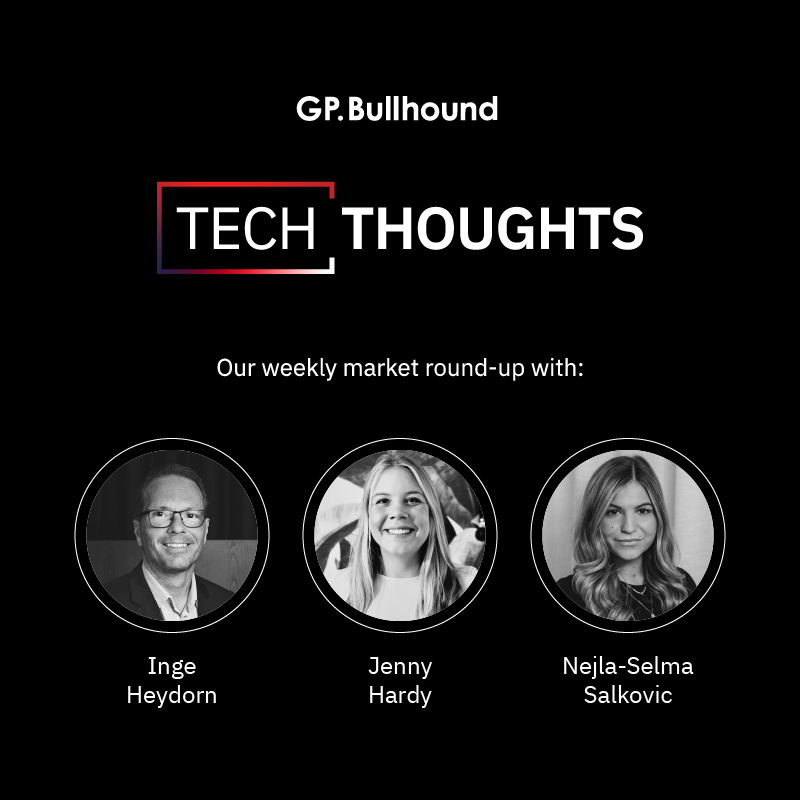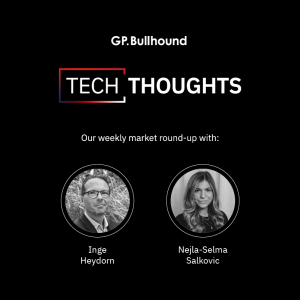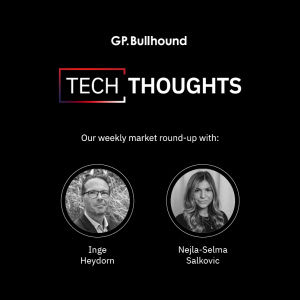Tech Thoughts Newsletter – 23 February 2024.

Market: All about Nvidia for the market (and our portfolio) this week – driving tech stocks higher.
Portfolio: We made no major changes to the portfolio this week.
Nvidia delivers another blowout quarter – all about pricing upside
- Nvidia (owned) reported another blowout quarter, exceeding market expectations and guiding significantly ahead of expectations.
- Our above-consensus view (we think Nvidia can beat next quarter’s guidance again) continues to focus on supply upside coming from node shifts and freed-up capacity at TSMC – TSMC’s November through January revenue was a good leading indicator of Nvidia’s GPU demand filling in 7nm and 5nm nodes, and the next data point we’re watching for is TSMC’s February release.
- Pricing (because volume is almost a given) is the key for continued strong growth through 2025/2026. Customers’ willingness to transition to the more performant (and higher ASP) H200 and then the B100 Blackwell chip, and the call spoke to strong pull forward demand (recall the timeline for the B100 has been accelerated) –this from the 10-K: “We expect our next-generation products to be supply-constrained based upon demand indications.”
- Why is volume a given? We continued to hear from many companies through Q4 earnings calls that they were waiting on supply of Nvidia GPUs, which are currently sold out. The cloud hyperscalers have all announced huge AI-driven capex plans – all have guided to increase capex in 2024 – and enterprise software businesses have all added AI capabilities to their offerings. We know every CEO in every industry is trying in some way to either build or gain access to Nvidia GPU capacity.
- Limited supply of wafer capacity at TSMC speaks to a significant short-term competitive advantage for Nvidia – on its balance sheet this quarter were $16bn purchase commitments (down from $17bn last quarter), which relate mostly to CoWoS and HBM, which have become the main bottlenecks in the AI supply chain.
- One debate the call added to is around networking, which is now running at an amazing $13bn annualised run rate. Nvidia spoke to continued strong demand for its Infiniband but also its new Spectrum-X ethernet product (which we think will compete directly with Arista and Cisco).
- The earnings call didn’t contain a considerable amount we didn’t already know (which is no bad thing), and the key question the market continues to grapple with is whether this level of demand sustainable. There are many ways to frame the shifting opportunity in AI – Jensen has spoken before about the idea of a $1trn of infrastructure spend ($250bn a year) which needs to shift to accelerated compute (to GPUs, to faster CPUs, to lower latency higher throughput networking equipment). If you think about Nvidia’s current revenue (its datacentre business will be ~$20bn in revenue next quarter) – it’s clear that we’re still in the very early innings of this shift:
There’s just no reason to update with more CPUs when you can’t fundamentally and dramatically enhance its throughput like you used to. And so you have to accelerate everything. This is what NVIDIA has been pioneering for some time. And with accelerated computing, you can dramatically improve your energy efficiency. You can dramatically improve your cost in data processing by 20 to 1. Huge numbers. And, of course, the speed. That speed is so incredible that we enabled a second industry-wide transition called generative AI.“
- The beauty of Nvidia’s fabless business model is the leverage – $16bn incremental revenue yr/yr is coming with less than $200m incremental opex. The top line drops straight through and has led to significant EPS growth (which leaves Nvidia, despite the general market perception, at still reasonable forward valuation levels. On our numbers ~30x 2024 EPS).
- There’s still somewhat of an unknown impact coming from China restrictions – we know that a lot of what could not be shipped (and China revenue came down significantly) went to alternative customers. We think a lot of the SuperMicro beat came down to them getting reallocated China supply. It means much of the China “risk” has gone away – China now accounts for just a mid-single digit % of Nvidia’s data centre revenue. Nvidia has reconfigured the products which are currently sampling to China (and could now be an upside to revenue expectations) – they’ll be competing with Huawei/SMIC’s AI Ascend GPU (though we note that it’s still not clear how much supply SMIC will be able to produce).
Portfolio view: We own Nvidia and AMD, and expect them to continue to be the biggest beneficiaries of downstream capex spend in 2024. Both make their chips at TSMC, which we own and further downstream, we expect to benefit from sustained capex spending through our semicap equipment exposure (we own ASML, LAM Research, KLA and Applied Materials). On the networking side, we own Broadcom, Arista and Cisco. And on the DSP (Digital signal processors side – sitting alongside GPUs) we own Marvell (wich has additional opportunities in some of the custom silicon ASICs built by the hyperscalers).
For Nvidia, we think the key to its outsized growth into 2026 is around its pricing power – and the willingness of customers to transition to its latest products – currently the H200 and later the B100 and X100, which we’ve written about previously.
“Spend fatigue” in cybersecurity
- Palo Alto (owned) significantly cut its billings guidance for 2024.
- While ~half of it was around a single US Fed deal, there is also a significant sales strategy pivot now going on at Palo Alto.
- We’ve spoken before about Palo Alto’s “platform” strategy – effectively Palo Alto being able to displace multiple vendors with their broad product offering. Now, they want to accelerate that by allowing customers to take Palo Alto’s platform solution product but only start paying for it once their legacy point solution contracts have ended.
- CEO Nikesh Arora spoke to the “spending fatigue” of customers:
Over the last few years, most of our customers have ended up spending more on cybersecurity than on IT. As a consequence, they’re feeling like their budget for cybersecurity keeps going up in double-digits every year because they’re trying to protect against every new threat vector.”
- It’s a bold strategy, and the question now is whether this is a short-term pain strategy, which will encourage customers to move wholeheartedly to Palo Alto’s solution, which will ultimately benefit them (winner takes all?) in the long run, or are they having to give their product away for free and will this mean a competitive price war in the cyber security space?
- The share price reaction of the whole space was significantly negative on the day (we think justifiably so – indeed the point solution vendors will fight hard and battle back with competitive pricing. In any case, there’s no getting away from Palo Alto implying the demand environment has significantly deteriorated).
Portfolio view: We had significantly reduced our position in Palo Alto after last quarter’s billings disappointment, and for now that remains our only pureplay cyber exposure in the portfolio. We still believe Palo Alto has the standout product set, but we’re cautious regarding demand and pricing in the short to mid-term as to how the space will evolve.
China, general purpose servers, and PC all remain tough
- Analog Devices (not owned) reported results a little ahead of consensus, but its April quarter guide was a miss, with communications and industrial particularly weak.
- They expect sales from all of their end markets to decline qtr/qtr, with industrial (we think particularly exposed to China) being the most negative.
- ADI is still suffering from higher inventories. We think the China channel inventories are particularly an issue, and it means it will likely have to continue shipping below already weak demand.
- Auto was relatively better, with management noting that it would be their best-performing end market for 2024.
- Their comments on the macro are worth highlighting (again, China weak): “The big question is the macroeconomic dial where that’s positioned. And I think at the margins, if I look at where we are this quarter versus last quarter, at least from a macro standpoint, maybe with the exception of China, we’re more bullish than we were…China has been weakest the longest.”
- Lenovo (not owned) offered weak guidance, impacted by the ongoing general purpose (not AI!) server slowdown and a still tough PC market. The hope is that (1) Lenovo can start to benefit from AI server demand and that this can more than offset the general purpose slowdown, and (2) that AI might result in a PC refresh cycle.
Portfolio view: One of the big question marks around end demand in 2024 remains China (and it’s an area we try to limit exposure to where we can). Outside of autos, the expected recovery in demand after the Covid reopening was much slower than anyone hoped for or predicted, and the economic data continues to be mixed. Companies have been reluctant to hire, and consumers have been unwilling to spend. For consumer tech, it could remain a significant headwind to demand. Despite the market bottoming, we still don’t like specific exposure to the PC and Android markets (unlike auto and AI, the content story in both is over, and both are fully-penetrated unit-wise). A potential upside driver we consider is AI computing at the edge, driving an upgrade cycle in smartphones and PCs.
Intel’s Foundry Day and chip incentives
- Intel held its “IFS Direct Connect” event and announced that Microsoft would be a foundry customer on its 18A node.
- It reiterated its “five nodes in four years” is on track and its focus on regaining manufacturing leadership in 2025.
- Intel also confirmed that two of its upcoming processors – we believe Lunar Lake and Arrow Lake – will be made at TSMC’s 3nm node. A large part of Intel’s latest processor (based on its Meteor Lake) is made at TSMC’s 5nm node, and one of the key questions for the industry has been whether Intel will stay or go back to internally sourcing. Remember, on its results call, TSMC gave some clues that they expect Intel to continue to be a significant share of 3nm volume:
Let me repeat the last time I came in on their technology. The comment stays the same, the technology would be very similar or equivalent to TSMC’s N3P. We further check again with all the specs, transistor technology and everything else. My comment stays the same, with a big advantage in the technology maturity. Because of, in 2025, when they say that their newest technology will to production. For TSMC, that will be the third year with a very high-volume production in the fabs.
So again, I don’t want to make too much of a comment on my customers’ claim, but let me assure you. We continue to have a technology leadership and we continue to have a broader base of customer and almost everybody, almost. They are working with TSMC.“
- In the tech leadership battle, more goals scored for TSMC.
- It was also reported in the press that Intel will receive $10bn of subsidies, and US Commerce Secretary Gina Raimondo was in person at the event.
- Also over the weekend, the US administration announced a $1.5bn grant to Global Foundries as part of the Chips Act.
Portfolio view: It’s too early to build an investment thesis on Intel’s foundry business; it’s still losing share to AMD in data centres, but it’s committed to spending, and that’s good news for us with semicap. There is a long way to go (and lots of EUV machines to buy) for Intel to get anywhere near TSMC’s position in leading-edge manufacturing. As we’ve said before, government incentives for localised chip production worldwide are helpful for semicap equipment. More localised fabs means more semicap equipment, and it remains one of the drivers of our above-consensus view on the space.
The 3nm outsourcing of Intel to TSMC is important for the ongoing tightness of supply at TSMC’s leading-edge nodes; it’s essential in clearly showcasing TSMC’s leadership (its biggest competitor has chosen to use their technology); and it’s important for Intel’s continued incentive to make its technology work, and to continue to spend large amounts of capex.

For enquiries, please contact:
Inge Heydorn, Partner, at inge.heydorn@gpbullhound.com
Jenny Hardy, Portfolio Manager, at jenny.hardy@gpbullhound.com
Nejla-Selma Salkovic, Associate, at nejla-selma.salkovic@gpbullhound.com
About GP Bullhound
GP Bullhound is a leading technology advisory and investment firm, providing transaction advice and capital to the world’s best entrepreneurs and founders. Founded in 1999 in London and Menlo Park, the firm today has 14 offices spanning Europe, the US and Asia.

